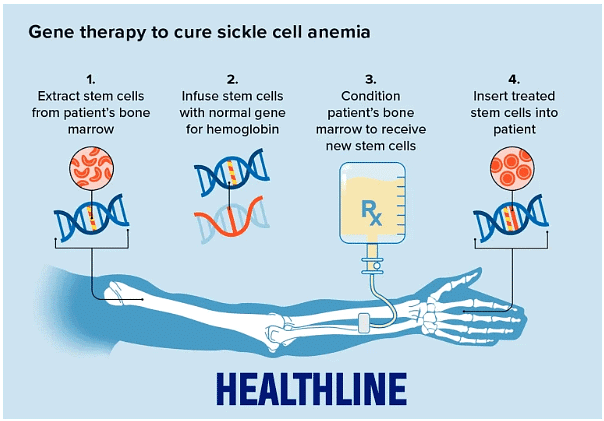UPSC Exam > UPSC Notes > Current Affairs & Hindu Analysis: Daily, Weekly & Monthly > The Hindu Editorial Analysis- 13th December 2023
The Hindu Editorial Analysis- 13th December 2023 | Current Affairs & Hindu Analysis: Daily, Weekly & Monthly - UPSC PDF Download

Game-changer
Why in News?
Less than a month after the UK drug regulator approved Casgevy, the gene therapy to treat people above 12 with sickle cell disease and beta thalassemia, the U.S. FDA has approved two gene therapies — Casgevy and Lyfgenia — to treat sickle cell disease in patients over 12.
What is Casgevy Therapy?
- This is the first licensed therapy in the world based on gene editing technology CRISPR-Cas9.
- It is a one-time therapy that edits the faulty gene that leads to these blood disorders, potentially curing the person for life.
How does the therapy work?
- Errors in the hemoglobin gene cause both sickle cell disease and thalassemia.
- The therapy uses the patient’s own blood stem cells, which are precisely edited using Crispr-Cas9.
- The therapy targets a gene called BCL11A, which is crucial for switching from fetal to adult hemoglobin.
- The therapy uses the body’s mechanisms to produce more foetal hemoglobin, alleviating the symptoms of the two conditions.
How is the therapy prepared and given?
- Apheresis: The first step is extracting blood stem cells from the bone marrow and filtering the blood for different components.
- Harvesting and Editing: The cells are then sent to the manufacturing site, which takes about six months to be edited and tested.
- Conditioning: Before a transplant with the edited cells, the doctor gives a conditioning medicine for a few days to clear the bone marrow of other cells that will be replaced by the modified cells.
- Transplantation: The patient has to stay in the hospital for at least a month so that the edited cells reside in the bone marrow and start making red blood cells with normal haemoglobin.
- Side effects: similar to those associated with autologous stem cell transplants, including nausea, fatigue, fever, and increased risk of infection.
What are the challenges of this treatment?
- High Cost of Treatment: a high proportion of people with these conditions live in poorer countries and are unlikely to be able to afford the therapy
- Estimates suggest it could be as much as $2 million per patient, which aligns with other gene therapies.
- Absence of Local Manufacturing Facilities: The harvested blood stem cells must be sent across countries.
- Earlier Treatment: Permanent treatment has been a bone marrow transplant.
- Donor rejection is the major challenge.
About sickle cell disease:
- Genetic Disorder: The genetic error in sickle cell disease leads to red blood cells assuming a crescent shape. (See image)
- Unlike the disc-shaped normal cells, the sickle-like cells cannot move around easily in the vessels, resulting in blocked blood flow.
- Effects: severe pain, life-threatening infections, anemia, or a stroke.
- Prelevance in India: An estimated 30,000-40,000 children in India are born with the disorder every year.
- Symptoms: The symptoms manifest in people who inherit a pair of damaged genes from both parents. Those who carry only one copy of the gene from one parent can lead a normal life.
Gene Therapy:
- Technique to replace defective genes with healthy genes to treat genetic disorders.
- Artificial method that introduces DNA into the cells of the human body.
- First developed in 1972, but has limited success.
- Two Major types of gene therapy: Somatic gene therapy and germline gene therapy.

Gene Editing:
- Gene editing is a technique of making specific changes to the DNA at a specific sequence.
- For this DNA is inserted, deleted, modified or replaced in the genome.
- For this CRISPR CAS9 (Genetic Scissor) is used.
- It involves cutting specific DNA sequences with ‘engineered nucleases’ enzymes.
About CRISPR-Cas9:
- CRISPR stands for ‘Clustered Regularly Interspaced Short Palindromic Repeats’.
- Cas9 stands for CRISPR-associated protein 9, & is the nuclease part that cuts the DNA.
- CRISPR is the DNA-targeting part of the system which consists of an RNA molecule, or ‘guide’, designed to bind to specific DNA bases through complementary base-pairing.
- The CRISPR-Cas9 system was originally discovered in bacteria that use this system to destroy invasions.
- It is the most common, cheap & efficient system used for genome editing.
About Thalassaemia:
- Thalassemia is an inherited (i.e., passed from parents to children through genes) blood disorder caused when the body doesn’t make enough of a protein called haemoglobin.
- Thalassaemia leads to low levels of haemoglobin and shows symptoms like fatigue, nausea, shortness of breath, and irregular heartbeats.
- People with the condition need blood transfusions throughout their life. The transfusions also lead to excess iron accumulation in the body, which needs chelation.
- India also has the largest number of children with thalassaemia major in the world about 1-1.5 lakh.
The document The Hindu Editorial Analysis- 13th December 2023 | Current Affairs & Hindu Analysis: Daily, Weekly & Monthly - UPSC is a part of the UPSC Course Current Affairs & Hindu Analysis: Daily, Weekly & Monthly.
All you need of UPSC at this link: UPSC
|
63 videos|5408 docs|1146 tests
|
Related Searches















